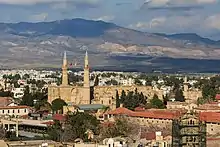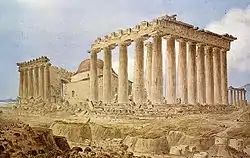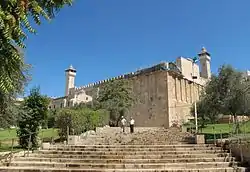Conversion of non-Islamic places of worship into mosques
The conversion of non-Islamic places of worship into mosques occurred during the life of Muhammad and continued during subsequent Islamic conquests and under historical Muslim rule. As a result, Hindu temples, Buddhist temples, Christian churches, synagogues, and Zoroastrian fire temples were converted into mosques. The practice has led to conflicts and religious strife in various parts of the world.[2][3][4]
.jpg.webp)
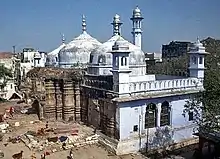
Several of such mosques in the areas of former Muslim rule have since been reconverted or become museums, such as the Parthenon in Greece, and numerous mosques in Spain such as Mosque–Cathedral of Córdoba etc. Conversion of non-Islamic buildings into mosques influenced distinctive regional styles of Islamic architecture.
Qur'anic holy sites
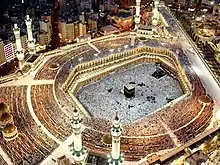
Mecca
Muslims believe the mosque at Ka'ba was rebuilt and used for monotheistic worship since the time of Ibrahim and Ismail.
Before Muhammad, the Kaʿba and Mecca (referred to as Bakkah in the Quran), were revered as a sacred sanctuary and was a site of pilgrimage.[5] Some identify it with the Biblical "valley of Baca" from Psalms 84 (Hebrew: בָּכָא).[6][7] At the time of Muhammad (AD 570–632), his tribe the Quraysh was in charge of the Kaʿaba, which was at that time a shrine containing hundreds of idols representing Arabian tribal gods and other religious figures. Muhammad earned the enmity of his tribe by preaching the new religion of Islam. Early Muslims practiced, or attempted to practice, their rituals by the Ka'aba alongside polytheists, until they eventually left Mecca, driven out by escalating persecution. The aborted first pilgrimage, which was prevented by the Quraysh, who promised to allow it the following year in the Hudaybiyah treaty, did not also entail the prevention of continuing practices by polytheists. However, before the second pilgrimage season, allies of the Quraysh violated the treaty, allowing the Muslims to return as conquerors rather than guests. Henceforth, the Kaʿaba was to be dedicated to the worship of the one God alone, and the idols were destroyed. The Black Stone (al-Hajar-ul-Aswad) at the Kaʿaba was a special object of veneration at the site. According to some traditions the text of seven or ten especially honoured poems were suspended around the Kaʿaba.[8]
Jerusalem
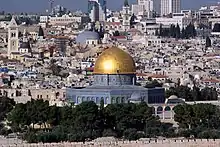
Upon the capture of Jerusalem, it is commonly reported that Umar, the Commander of the Faithful, refused to pray in the Church of the Holy Sepulchre in spite of a treaty.[9] The architecturally similar Dome of the Rock was built on the Temple Mount, which was an abandoned and disused area since 70 AD in the 7th century but which had previously been the site of the Jewish Temple in Jerusalem, the most sacred site in Judaism.[10] Umar initially built there a small prayer house which laid the foundation for the later construction of the Al-Aqsa mosque by the Umayyads.[11]
Elsewhere
The mosque of Job in Al-Shaykh Saad, Syria, was previously a church of Job.[12]
The Herodian shrine of the Cave of the Patriarchs in Hebron, the second most holy site in Judaism,[13] was converted into a church during the Crusades before being turned into a mosque in 1266 and henceforth banned to Jews and Christians.[14] Part of it was restored as a synagogue by Israel after 1967.[15] Other sites in Hebron have undergone Islamification. The Tomb of Jesse and Ruth became the Church of the Forty Martyrs,[16] which then became the Tomb of Isai and later Deir Al Arba'een.[17]
Hindu, Jain and Buddhist temples
Bindu Madhav (Nand Madho) Temple
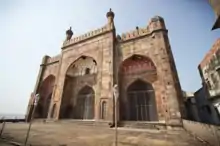
The Alamgir Mosque in Varanasi was constructed by Mughal Emperor Aurnagzeb built atop the ancient 100 ft high Bindu Madhav (Nand Madho) Temple after its destruction in 1682.
Kashi Vishwanath Temple
The original Kashi Vishwanath Temple was demolished by Aurangzeb, the sixth Mughal emperor who constructed the Gyanvapi Mosque atop the original Hindu temple. Kashi Vishwanath was among the most renowned Hindu temples of India. Even today the pillars and the structure of the original temple can be clearly seen.
Aurangzeb's demolition of the temple was motivated by the rebellion of local zamindars (landowners) associated with the temple, some of whom may have facilitated the escape of the Maratha king Shivaji. Jai Singh I, the grandson of the temple's builder Raja Man Singh, was widely believed to have facilitated Shivaji's escape from Agra.[18] The temple's demolition was intended as a warning to the anti-Mughal factions and Hindu religious leaders in the city.[19]
As described by Jadunath Sarkar, on 9 April 1669, Aurangzeb issued a general order “to demolish all the schools and temples of the infidels and to put down their religious teaching and practices.” His destroying hand now fell on the great shrines that commanded the veneration of the Hindus all over India—such as the second temple of Somnath, the Vishwanath temple of Benares and the Keshav Rai temple of Mathura.[20]
Sikh Gurdwaras
Gurdwara Lal Khoohi
Gurdwara Lal Khoohi in Lahore, Pakistan was a Sikh Gurdwara which was converted to muslim shrine.[21][22]
Gurudwara Pehli Patshahi
Gurudwara Pehli Patshahi (Bhai Bala Di Baithak) dedicated to Bhai Bala was a Sikh Gurudwara at Balakot, Mansehra district of Pakistan which was converted into Bala Pir muslim shrine (Bala Pir Ziarat) after beheading of Syed Ahmad Barelvi by Sikh Empire forces in 1831 Battle of Balakot.[23][24][25]
Zoroastrian fire temples
After the Islamic conquest of Persia, Zoroastrian fire temples, with their four axial arch openings, were usually turned into mosques simply by setting a mihrab (prayer niche) on the place of the arch nearest to qibla (the direction of Mecca). This practice is described by numerous Muslim sources; however, the archaeological evidence confirming it is still scarce. Zoroastrian temples converted into mosques in such a manner could be found in Bukhara, as well as in and near Istakhr and other Iranian cities,[12] such as: Tarikhaneh Temple, Jameh Mosque of Qazvin, Heidarieh Mosque of Qazvin, Jameh Mosque of Isfahan, Jameh Mosque of Kashan, Jameh Mosque of Ardestan, Jameh Mosque of Yazd, Jameh Mosque of Borujerd, Great Mosque of Herat as well as Bibi Shahr Banu Shrine near Tehran.
Conversion of church buildings to mosques
Albania
The Catholic church of Saint Nicholas (Shën Nikollë) was turned into a mosque. After being destroyed in the Communist 1968 anti-religious campaign, the site was turned into an open air mausoleum.
Bosnia and Herzegovina
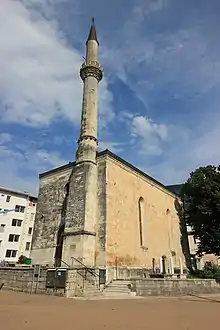
The Fethija Mosque (since 1592) of Bihać was a Catholic church devoted to Saint Anthony of Padua (1266).
Istanbul
Following the Ottoman conquest of Anatolia, virtually all of the churches of Istanbul were converted into mosques except the Church of St. Mary of the Mongols.[26]
- Hagia Sophia (from the Greek: Ἁγία Σοφία, "Holy Wisdom"; Latin: Sancta Sophia or Sancta Sapientia; Turkish: Ayasofya) was the cathedral of Constantinople in the state church of the Roman Empire and the seat of the Eastern Orthodox Church's Patriarchate. After 1453 it became a mosque, and since 1931 it has been a museum in Istanbul, Turkey. From the date of its dedication in 360 until 1453, it served as the Orthodox cathedral of the imperial capital, except between 1204 and 1261, when it became the Roman Catholic cathedral under the Latin Patriarch of Constantinople of the Western Crusader-established Latin Empire. In 1453, Constantinople was conquered by the Ottoman Turks under Sultan Mehmed II, who subsequently ordered the building converted into a mosque.[27] The bells, altar, iconostasis, ambo and sacrificial vessels were removed and many of the mosaics were plastered over. Islamic features – such as the mihrab, minbar, and four minarets – were added while in the possession of the Ottomans. The building was a mosque from 29 May 1453 until 1931, when it was secularised. It was opened as a museum on 1 February 1935.[28] On July 10, 2020, the decision of the Council of Ministers to transform it into a museum was canceled by Council of State and the Turkish President Erdoğan signed a decree annulling the Hagia Sophia's museum status, reverting it to a mosque.[29][30]
- The Church of the Holy Apostles became the cathedral church and seat of the patriarchate for three years after the Fall of Constantinople, as Hagia Sophia became the city's Jama masjid. The Justinianic church was already in disrepair and in 1461 it was demolished and the Fatih Mosque was erected in its place.
- The Church of the Pantocrator, a church favoured for imperial burials in the latter Byzantine Empire, became the Zeyrek Mosque.
- The Church of SS Sergius and Bacchus, a church built by Justinian I, became a mosque dubbed the Little Hagia Sophia.
- The Church of Saint Andrew in Krisei, became the Koca Mustafa Pasha Mosque.
- The Church of Saint Thekla of the Palace of Blachernae, became the Atik Mustafa Pasha Mosque.
- The nunnery of Saint Theodosia, became the Gül Mosque.
- The Chora Church became the Kariye Mosque.
- The Monastery of Stoudios became the İmrahor Mosque.
- The Church of Saint John the Forerunner by-the-Dome became the Hirami Ahmet Pasha Mosque.
- The Church of Myrelaion became the Bodrum Mosque.
- The Catholic Church of Saint Paul became the Arap Mosque.
- The Lips Monastery became the Fenari Isa Mosque.
- The Monastery of Christ Pantepoptes became the Eski Imaret Mosque.
- The Church of Theotokos Kyriotissa became the Kalenderhane Mosque.
- The Church of Hagios Theodoros at Vefa became the Church-Mosque of Vefa.
- The Monastery of Manuel became the Kefeli Mosque.
- The Monastery of Gastria became the Sancaktar Hayrettin Mosque.
- The Church of Saint Mary of Constantinople became the Odalar Mosque.
- The Pammakaristos Church became the Fethiye Mosque.
- The Toklu Dede Mosque was an Eastern Orthodox church of unknown dedication.
- The monastery of the Holy Martyrs Menodora, Metrodora, and Nymphodora became the Manastır Mosque.
Rest of Turkey
Elsewhere in Turkey numerous churches were converted into mosques, including:
Orthodox
- Hagia Sophia Church in Nicaea (İznik)
- Hagia Sophia Church in Trebizond (Trabzon)
- Panagia Chrysokephalos Church, became the Fatih Mosque in Trabzon (Trabzon)
- Nakip Mosque was a Byzantine church. (Trabzon)
- Hagios Eugenios Church, became the New Friday Mosque (Trabzon)
- Saint Paul Cathedral, became the Tarsus Old Mosque (Tarsus)
- Church of Virgin Mary, became the Kesik Minare (Antalya)
- Church of Christ and Saint Stephen, became the Fatih Mosque in Tirilye (Tirilye)
Armenian Apostolic
Hundreds of Armenian Churches were converted into Mosques in Turkey and Azerbaijan. Thousands were destroyed after Armenian Genocide in 1915
- Cathedral of Kars
- Cathedral of Ani
- Liberation Mosque, ex St Mary's Church Cathedral, Gaziantep
20th century and after
In addition, after the Greco-Turkish War (1919–1922), some of the Greek Orthodox churches in Turkey were converted into mosques. In 2015, Turkey decided to renovate the ruined Hagia Sophia church in Enez, dating back to the 12th century, as a mosque despite former statements made about the possibility of restoring it as a museum.[31] As of 2020, four Byzantine church museums converted to mosques under Erdogan's rule (including the Haghia Sophia in İznik (2011),[32] the Chora Church in Istanbul (2019)[33] and the Haghia Sophia in Istanbul (2020)).[34]
Cyprus
Following the Ottoman conquest of Cyprus, a number of Christian churches were converted into mosques. A relatively significant surge in church-mosque conversion followed the 1974 Turkish Invasion of Cyprus. Many of the Orthodox churches in Northern Cyprus have been converted, and many are still in the process of becoming mosques.
- St. Nicholas Cathedral in Famagusta, Cyprus was converted by the Ottoman Turks into Lala Mustafa Pasha Mosque in 1571; remains in use as mosque today.
- St. Sophia Cathedral in Nicosia, Cyprus was converted by the Ottoman Turks into the Selimiye Mosque, Nicosia; remains in use as mosque today.
France
During the Ottoman wintering in Toulon (1543–44), the Toulon Cathedral was temporarily used as a mosque for the 30,000 members of the crew of the Ottoman fleet.
Greece
Numerous orthodox churches were converted to mosques during the Ottoman period in Greece. Among them:
- The Church of the Acheiropoietos (Eski Mosque), the Church of Hosios David (Suluca or Murad Mosque), the Church of Prophet Elijah (Saraylı Mosque), the Church of Saint Catherine (Yakup Pasha Mosque), the Church of Saint Panteleimon (Ishakiye Mosque), the Church of Holy Apostles (Soğuksu Mosque), the Church of Hagios Demetrios (Kasımiye Mosque), the Rotonda of Galerius (Mosque of Suleyman Hortaji Effendi) in Thessaloniki.
- The Cathedral church of Veria (Hünkar Mosque) and the Church of Saint Paul in Veria (Medrese Mosque).
- The Church of Saint John in Ioannina, destroyed by the Ottomans and the Aslan Pasha Mosque was built in its place.
- The Theotokos Kosmosoteira monastery in Feres was converted into a mosque in the mid-14th century.
- Parthenon in Athens: Some time before the close of the fifteenth century, the Parthenon became a mosque. Before that the Parthenon had been a Greek Orthodox church.
- The Fethiye Mosque in Athens was built on top of a Byzantine basilica. It is currently an exhibition centre.
.jpg.webp)
Hungary
Following the Ottoman conquest of the Kingdom of Hungary, a number of Christian churches were converted into mosques. Those that survived the era of Ottoman rule, were later reconverted into churches after the Great Turkish War.
- Church of Our Lady of Buda, converted into Eski Djami immediately after the capture of Buda in 1541, reconverted in 1686.
- Church of Mary Magdalene, Buda, converted into Fethiye Djami c. 1602, reconverted in 1686.
- The Franciscan Church of St John the Baptist in Buda, converted into Pasha Djami, destroyed in 1686.
Lebanon
- Al-Omari Grand Mosque in Beirut, Lebanon; built as the Church of St. John the Baptist by the Knights Hospitaller; converted to mosque in 1291.
Morocco
- Grand Mosque of Tangier; built as Church
Spain
A Catholic Christian church dedicated to Saint Vincent of Lérins, was built by the Visigoths in Córdoba; during the reign of Abd al-Rahman I, it was converted into a mosque.[35][36][37] In the time of the Reconquista, Christian rule was reestablished and the building became a church once again, the Cathedral of Our Lady of the Assumption.[35][36][37]
Syria
- Umayyad Mosque in Damascus; built on the site of a Christian basilica dedicated to John the Baptist (Yahya), which was earlier, a Roman Pagan temple of Jupiter.
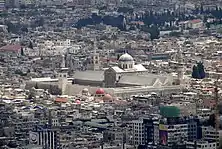 Umayyad Mosque mosque was built on the site of a Christian basilica dedicated to John the Baptist, which was earlier a Temple of Jupiter converted into a cathedral by the Roman emperor Theodosius I
Umayyad Mosque mosque was built on the site of a Christian basilica dedicated to John the Baptist, which was earlier a Temple of Jupiter converted into a cathedral by the Roman emperor Theodosius I - Great Mosque of al-Nuri in Homs; initially a pagan temple for the sun god ("El-Gabal"), then converted into a church dedicated to Saint John the Baptist
- Great Mosque of Hama; a temple to worship the Roman god Jupiter, later it became a church during the Byzantine era
- Great Mosque of Aleppo; the agora of the Hellenistic period, which later became the garden for the Cathedral of Saint Helena
Post-Colonial North Africa
A number of North African cathedrals and churches were converted into mosques in the mid-20th century
- St. Philip Cathedral in Algiers, Algeria (originally a mosque, converted to a church in 1845, reconverted to the Ketchaoua Mosque in 1962)
- Cathédrale Notre-Dame des Sept-Douleurs in Constantine, Algeria
- Tripoli Cathedral in Tripoli, Libya (converted to Maidan al Jazair Square Mosque)
Iraq
The Islamic State of Iraq and Syria converted a number of Christian churches into mosques after they occupied Mosul in 2014. The churches were restored into its original functions after Mosul was liberated in 2017.[38]
- Syrian Orthodox Church of St. Ephraim in Mosul, Iraq; converted to the Mosque of the Mujahideen
- Chaldean Church of St. Joseph in Mosul, Iraq
Israel
- Church of Saint James Intercisus in the Old City of Jerusalem, transformed into Al-Yaqoubi Mosque
- Templum Domini (Dome of the Ascension, Dome of the Rock)
- Tomb of the Patriarchs
- Tombs of Nathan and Gad in Halhoul, transformed into Mosque of Prophet Yunus.[40][41]
Influence on Islamic architecture
Conversion of non-Islamic religious buildings into mosques during the first centuries of Islam played a major role in the development of Islamic architectural styles. Distinct regional styles of mosque design, which have come to be known by such names as Arab, Persian, Andalusian, and others, commonly reflected the external and internal stylistic elements of churches and other temples characteristic for that region.[42]
See also
- Conversion of non-Hindu places of worship into temples
- Christianized sites
- Conversion of mosques into non-Islamic places of worship
- Islam and other religions
- List of destroyed heritage
- Meštrović Pavilion, a museum in Croatia re-arranged as a mosque in 1941-1945
References
- name="Reginald_1829"https://archive.org/stream/narrativeofjourn01hebe#page/258/mode/2up
- https://greekcitytimes.com/2019/04/29/historical-st-nicholas-cathedral-in-cyprus-turned-into-a-mosque-under-turkish-occupation/?amp
- "Archived copy". Archived from the original on 17 January 2008. Retrieved 26 September 2010.CS1 maint: archived copy as title (link)
- Uproar over India mosque report: Inquiry into Babri mosque's demolition in 1992 Archived 31 January 2010 at the Wayback Machine Al-Jazeera English – 24 November 2009
- Britannica 2002 Deluxe Edition CD-ROM, "Ka'bah."
- Daniel C. Peterson (2007). Muhammad, prophet of God. Wm. B. Eerdmans Publishing. pp. 22–25. ISBN 978-0-8028-0754-0.
- Psalms 84:6, King James Version
- Amnon Shiloah (2001). Music in the World of Islam: A Socio-Cultural Study. Wayne State University Press. p. 4. ISBN 9780814329702.
- Adrian Fortescue, "The Orthodox Eastern Church", Gorgias Press LLC, 1 December 2001, pg. 28 ISBN 0-9715986-1-4
- Orlin, Eric (19 November 2015). Routledge Encyclopedia of Ancient Mediterranean Religions. ISBN 9781134625598. Retrieved 7 May 2016.
- Le Strange, Guy (1890). Palestine Under the Moslems. p. 10.
It seems probable, also, that this latter Khalif, when he began to rebuild the Aksa, made use of the materials which lay to hand in the ruins of the great St. Mary Church of Justinian, which must originally have stood on the site, approximately, on which the Aksa Mosque was afterwards raised.
- Hillenbrand, R. "Masdjid. I. In the central Islamic lands". In P.J. Bearman; Th. Bianquis; C.E. Bosworth; E. van Donzel; W.P. Heinrichs (eds.). Encyclopaedia of Islam Online. Brill Academic Publishers. ISSN 1573-3912.
- Johnson, Paul (14 September 1988). A History of the Jews. Harper Collins. pp. 3–5. ISBN 978-0-06-091533-9.
- Tristram, Henry Baker (1865). The land of Israel: a journal of travels in Palestine, undertaken with special reference to its physical character. London: Society for Promoting Christian Knowledge. pp. 390–396.
- Goren, Shlomo (2016). With Might and Strength: An Autobiography. Maggid. ISBN 978-1592644094.
- Pringle, Denys (1993). The Churches of the Crusader Kingdom of Jerusalem: A Corpus: Volume 2, L-Z (excluding Tyre). Cambridge University Press. ISBN 978-0-521-39037-8.
- Sharon, Moshe. Corpus Inscriptionum Arabicarum Palaestinae, Volume Five: H-I. ISBN 9004250972.
- Truschke, Audrey (16 May 2017). Aurangzeb: The Life and Legacy of India's Most Controversial King. Stanford University Press. ISBN 9781503602595.
- Catherine B. Asher (24 September 1992). Architecture of Mughal India. Cambridge University Press. pp. 278–279. ISBN 978-0-521-26728-1.
- Sarkar, Jadunath (1930). A Short history of Aurangzib. Calcutta: M.C Sarkar & Sons. pp. 155–156.
- "Lahore's historical gurdwara now a Muslim shrine". The Tribune. 14 June 2016. Retrieved 7 August 2020.
- Sheikh, Majid (17 February 2019). "HARKING BACK: Fateful route of a great Guru as he walked to his death". DAWN.COM. Retrieved 7 August 2020.
- Khalid, Haroon (4 March 2019). "Pakistan's Balakot is linked to puritanical Islam – but it also has a syncretic religious tradition". Scroll.in. Retrieved 12 October 2020.
- Khalid, Haroon (6 March 2019). "The little-known religious history of Balakot". DAWN.COM. Retrieved 12 October 2020.
- "Gurudwara Pehli Patshahi at BalaKot". Gateway To Sikhism. 27 January 2014. Retrieved 12 October 2020.
- Mamboury (1953), p. 221.
- "Archnet". Archived from the original on 5 January 2009. Retrieved 13 February 2009.
- Magdalino, Paul; et al. "Istanbul: Buildings, Hagia Sophia". Grove Art Online. Archived from the original on 10 December 2010. Retrieved 28 February 2010.
- https://www.aa.com.tr/tr/turkiye/ayasofyayi-camiden-muzeye-donusturen-bakanlar-kurulu-kararina-iptal-/1906077
- "Hagia Sophia: Turkey turns iconic Istanbul museum into mosque". BBC. 10 July 2020. Retrieved 10 July 2020.
- Historic Hagia Sophia in a Turkish province to be re-opened as mosque
- Letsch, Constanze (2 December 2011). "Turkey: Mystery Surrounds Decision to Turn Byzantine Church Museum into a Mosque". eurasianet.org. Retrieved 2 December 2011.
- YACKLEY, AYLA JEAN (2 July 2020). "From museum to mosque? Turkish court to rule on Hagia Sophia's fate". politico.eu. Retrieved 2 July 2020.
- Gall, Carlotta (15 July 2020). "Erdogan Signs Decree Allowing Hagia Sophia to Be Used as a Mosque Again". The New York Times. Retrieved 17 July 2020.
- Christys, Ann (2017). "The meaning of topography in Umayyad Cordoba". In Lester, Anne E. (ed.). Cities, Texts and Social Networks, 400–1500. Routledge.
It is a commonplace of the history of Córdoba that in their early years in the city, the Muslims shared with the Christians the church of S. Vicente, until ʿAbd al-Raḥmān I bought the Christians out and used the site to build the Great Mosque. It was a pivotal moment in the history of Córdoba, which later historians may have emphasised by drawing a parallel between Córdoba and another Umayyad capital, Damascus. The first reference to the Muslims’ sharing the church was by Ibn Idhārī in the fourteenth century, citing the tenth-century historian al-Rāzī. It could be a version of a similar story referring to the Great Mosque in Damascus, which may itself have been written long after the Mosque was built. It is a story that meant something in the tenth-century context, a clear statement of the Muslim appropriation of Visigothic Córdoba.
- Guia, Aitana (1 July 2014). The Muslim Struggle for Civil Rights in Spain, 1985–2010: Promoting Democracy Through Islamic Engagement. Sussex Academic Press. p. 137. ISBN 978-1-84519581-6.
It was originally a small temple of Christian Visigoth origin. Under Umayyad reign in Spain (711–1031 CE), it was expanded and made into a mosque, which it would remain for eight centuries. During the Christian reconquest of Al-Andalus, Christians captured the mosque and consecrated it as a Catholic church.
- Armstrong, Ian (2013). Spain and Portugal. Avalon Travel Publishing. ISBN 978-1-61237031-6.
On this site originally stood the Visigoths' Christian Church of San Vicente, but when the Moors came to town in 758 CE they knocked it down and constructed a mosque in its place. When Córdoba fell once again to the Christians, King Ferdinand II and his successors set about Christianizing the structure, most dramatically adding the bright pearly white Renaissance nave where mass is held every morning.
- "Iraq: Daesh have robbed and demolished every church". Independent Catholic News. 6 March 2018. Archived from the original on 20 March 2018. Retrieved 20 March 2018.
- Tristram, Henry Baker (1865). The land of Israel : a journal of travels in Palestine, undertaken with special reference to its physical character. London: London Society for Promoting Christian Knowledge. p. 394.
The design is unique and patriarchal in its magnificent simplicity. One can scarcely tolerate the theory of some architectural writers, that this enclosure is of a period later than the Jewish. It would have been strange if any of the Herodian princes should here alone have raised, at enormous cost, a building utterly differing from the countless products of their architectural passion and Roman taste with which the land is strewn.
- "For first time in 18 years, Jews pray at biblical tombs in Palestinian village". Times of Israel. AFP. Retrieved 20 July 2020.
- Adler, Elkan Nathan (4 April 2014). Jewish Travellers. Routledge. p. 135. ISBN 978-1-134-28606-5.
"From there we reached Halhul, a place mentioned by Joshua. Here there are a certain number of Jews. They take travelers to see an ancient sepulchral monument attributed to Gad the Seer." — Isaac ben Joseph ibn Cehlo, 1334
- Patrick D. Gaffney (2004). "Masjid". In Richard C. Martin (ed.). Encyclopedia of Islam and the Muslim World. MacMillan Reference.
